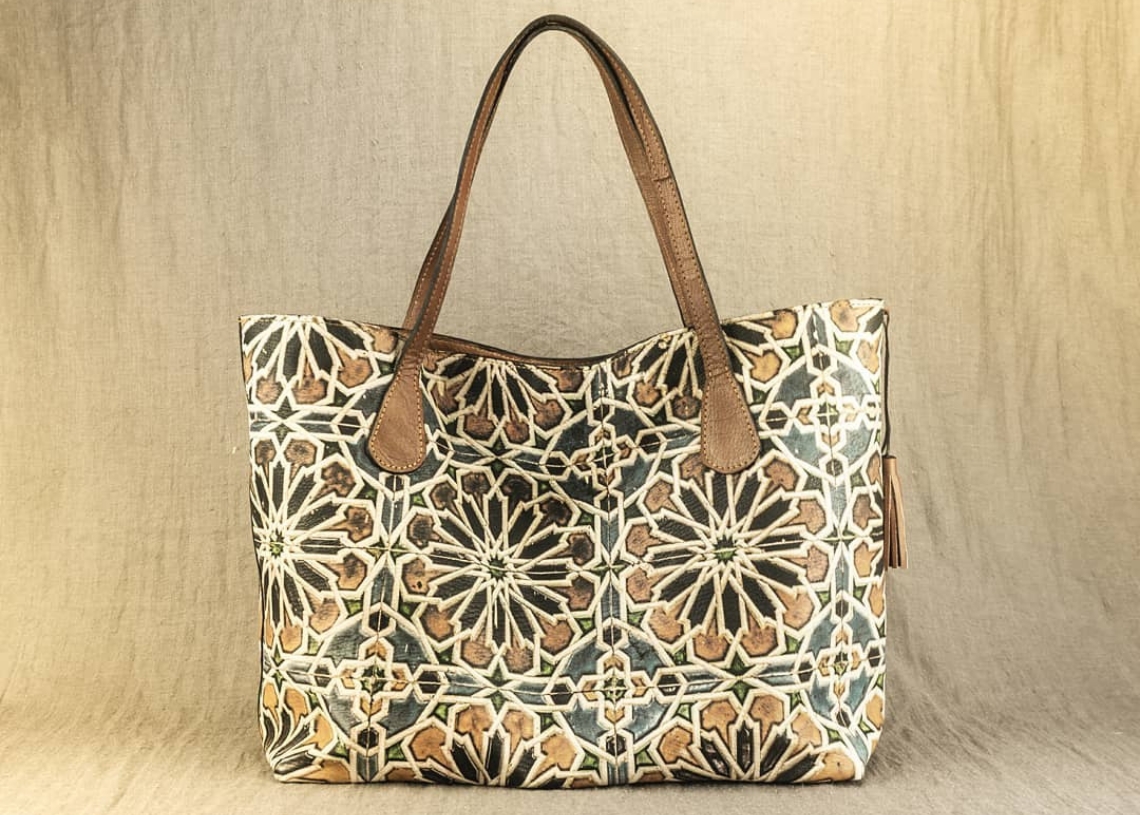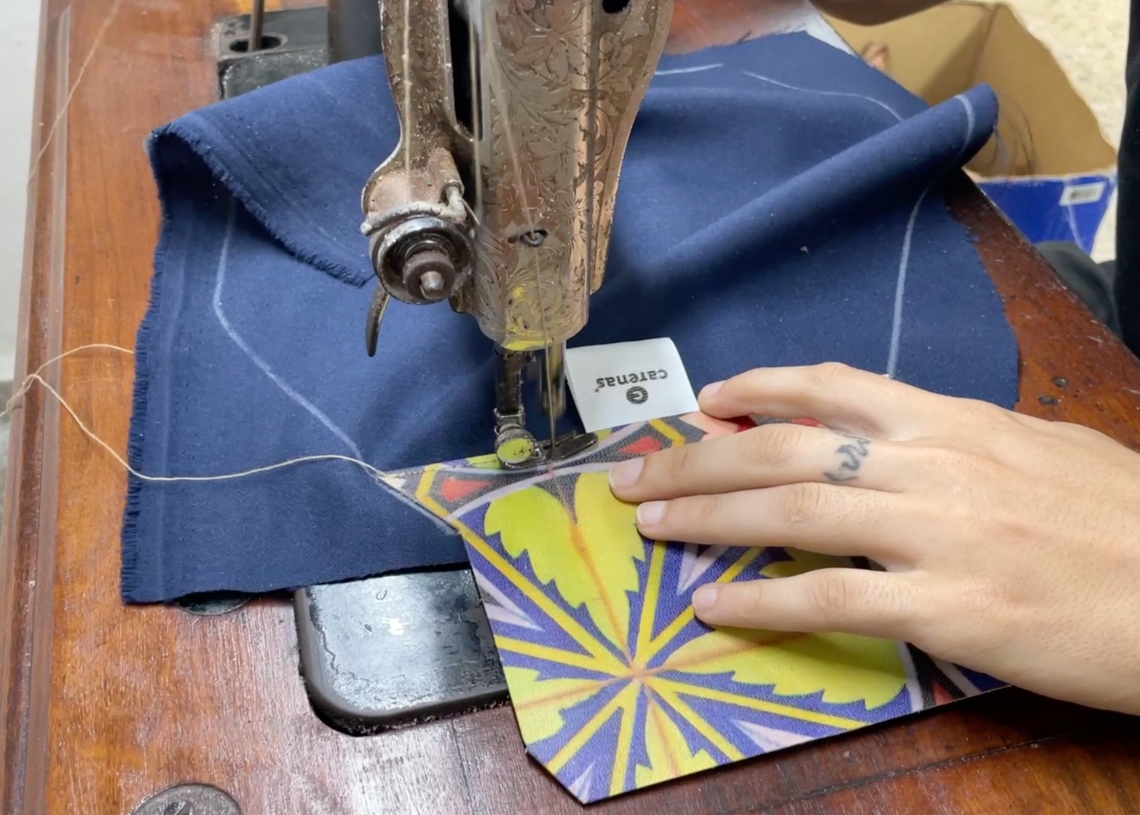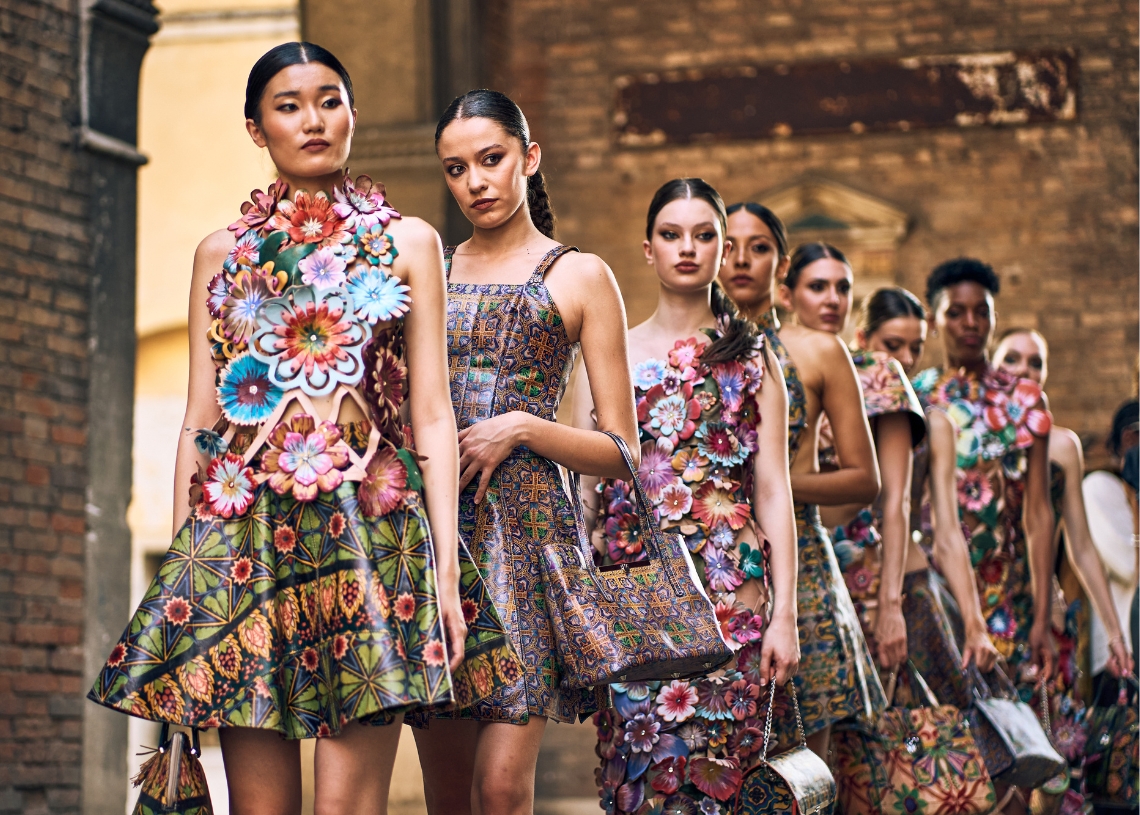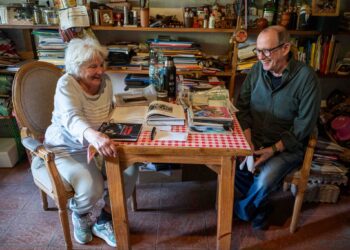They are the only ones in Cuba using the technique of printing on leather, taking a material that is an important part of Cuban artisanal traditions and elevating it to a new level. After seven years of work, Carenas is, without a doubt, Cuban haute couture.
Its pieces impress with their design, good taste, sensitivity and concept. One might imagine that behind them lies an industry with a robust infrastructure. But no.
Carenas operates out of a small workshop with Singer sewing machines from the 1920s, with fewer than five employees, but plenty of passion, dedication and a well-defined vision shaped by the hands and minds of Raisa Cortina and Manuel Olivera, even though neither of them has formal training in design or any related aspect of fashion.
From that small workshop and their artistry have emerged a dozen collections since the brand was launched in 2018. Having already made a name for themselves in Cuba’s burgeoning fashion scene, they have graced runways in France, Geneva and Italy, and in 2024 they won the International Award for Best Collection at the Venice International Fashion Show.
“The idea for Carenas arose from the need to find a product, a style of fashion, that spoke a language closer to our times. We started selling at the craft fair of the Cuban Association of Artisans and Artists (ACAA) on Obispo Street, and there we first encountered a material as rich as leather,” Manuel Olivares tells us.
“Carenas started with just the two of us making the pieces. We worked all night long, we didn’t even have a workshop, we only had one sewing machine, and it would take us an entire night to make a wallet,” Raisa recalls. “We started learning a bit, immersing ourselves in the world of fashion, and also in the techniques for working with it, and we kept perfecting all of that. We’ve done everything at Carenas, from community managers to directors, we’ve covered absolutely every aspect, but now we’ve managed to build a team that really complements each other well, and we’ve been transforming everything, professionalizing the brand.”
Everything changed
Carenas’ first collections, presented in 2019, played with shapes and geometries. It was clear that there was a specific language with leather, and above all, a desire to attract attention and show that leather could break free from the “traditional” role that had been assumed in the Cuban market for this type of product.
Then doors began to open, and with them, challenges. This is how the techniques and concepts arrived that transformed the brand’s entire aesthetic and have paved the way to where it is today.
“In 2019, Havana celebrated its 500th anniversary, and we were going to inaugurate an exhibition at Estudio 50 as part of the Art and Fashion event. We were to share the design space with a professor from Parsons The New School for Design in New York, who also has a handbag brand. We had to create something representative of each artist’s work that incorporated a part of Havana,” Raisa recounts.
“When they made us the proposal, we decided to create something unique. We wanted it to be a conceptual look at Havana. Not so descriptive, not so basic,” Manuel explains.
This is how the idea of exploring Havana’s architecture was born. Seeking a path beyond the usual postcards, they came across the Inglaterra Hotel and its Mudejar-style mosaics.

“Fashion, like all art forms, is about trying to communicate your vision, but also based on a concept. We also like that people have to decipher it,” explains Manuel.
“We also tested it on a machine to see if we could print on leather, and it worked,” says Raisa. They arrived at printing, a technique used in many parts of the world, but until then, no one had dared to try it or had succeeded on the island.
For that collective exhibition called Global Visual they presented five handbags. The public’s positive reception encouraged them to expand the project into a full collection called Grand Inglaterra, but by the time it was ready, it was 2020, and the world stopped.
“We launched a collection of 12 bags, and it was right then that the pandemic hit. We were supposed to have a fashion show the weekend everything shut down, and in July we decided to release it online. A whole photoshoot had already been done, and that’s how it started to be known,” says Raisa.
The label
Grand Inglaterra gave Carenas much of its artistic essence. The mosaics and stained-glass windows of various parts of the city have served as inspiration for blending architecture and fashion to this day. But vision and clear guidelines have been the key to the brand’s current positioning.
Manuel tells us about these aspects, which, obviously, haven’t been a straightforward path either.
“At the beginning, it was more of an artisanal brand, and now we’re more closely linked to fashion, but the mission has always been the same: to offer, not only to our generation but to the general public, a Cuban-designed, handmade product, and to revive the richness of a material as timeless as leather.”

However, the brand doesn’t abandon the artisanal concept when designing its products. “Carenas is a brand that produces on a small scale, meaning it doesn’t produce wholesale, and that’s one of the things we maintain as a hallmark of quality that can’t be lost,” explains Raisa.
“Each piece passes through our hands, represents hours of work, tells a story and carries a bit of our spirit,” reaffirms Manuel.
All the materials used at Carenas are one hundred percent Cuban. The leather comes from other artisan hands, those of the tanners, who in turn work with the surplus hides from meat processing intended for food. Symbiosis and sustainability are clearly other important values of the brand.
Its leaders also speak to us of “the perspective and vision of our times,” and that’s where the structural designs of each piece come into play as a hook to connect with fashion and the tastes of today’s public.
“In a world that moves so fast, where every day we consume more and more, we’re committed to the inherent value of leather in terms of richness and durability,” says Manuel.
“It’s not just a bag; it’s everything behind that bag: people who are working, striving, studying. It carries a weight that takes time to uncover and for people to begin accepting that something of high quality can exist here, something made without having to go looking for it abroad,” Raisa observes.
To date, the brand only sells online, by order. They maintain a catalog of over 70 designs from all their collections and each piece is made to order within a maximum of 15 days and delivered personally.
Island
In June of this year, Carenas participated again in the Venice International Fashion Concert in Italy. After the success and award received for their presence at the event in 2024, they felt the need to explore more diverse concepts and aesthetics.

Furthermore, their three years of experience at international events have provided them with the tools to understand the concept of creating and presenting a collection in other disemsions.
“When you participate in an international fashion show, you have to go a little further and not just bring an accessory. We have tried to create outfits each year with each collection, not focused on being utilitarian — although they are, because they meet the requirements — but on offering a glimpse into the highest artistic expression of the collection.
“It’s about bringing to life on the runway all the research we do into art history, architecture, why we choose each mosaic, why each area. We want people who attend the shows to leave feeling something. We don’t want them to just see a pretty bag or a piece, but also to see and feel the narrative it tells,” Manuel explains.
This is how Island, the latest collection, was born, a collection that speaks not only of Cuba, but of the geographical region we inhabit. Floral elements were added as a new aesthetic and artisanal feature.
Carenas proudly boasts of having created three thousand flowers entirely by hand to construct the true works of art that graced the runway at the presentation of this collection in Venice.

“We sought out four mosaics that had a strong tropical color palette and very floral, very vegetative forms. With the flowers, we wanted to revive that very manual tradition, but also based on a very artistic perspective. The pieces were conceived almost as sculptures because the mesh was made, then molded on top of the mannequins to create the shape of the body with all the flowers, and we chose flowers native to the Caribbean.
“We had always talked in all our collections about this cross-cultural process; about how different cultures nourished each other. We drew from the Old World, the Old World of our colors and, in this collection, it was like saying purely, ‘We are the Caribbean, we have this richness and we are going to highlight it.’ It’s about highlighting what our own essence means,” Raisa explains.
The designers can’t choose a favorite collection. They feel each one as a new step that has shaped or redirected their path, and that’s the only way to grow.
Changes in techniques, inspirations and languages; a wider range of pieces to create; experimentation with different materials while still giving leather center stage — in short, evolution, which is only possible with a clear vision and objectives.
“The key will always be pursuing your dreams above all else, in any context,” Manuel summarizes.
“An entrepreneur never rests. You always have to have new ideas, you always have to reinvent yourself in every way: with your surroundings, with your own essence, with your own work. That’s the most important thing. And never stop dreaming so that when you reach your goals, you feel the need to go even further. So that you know and are truly identified with what you want to be and show the world. That’s the essence of everything, and from there all the ideas come, everything arises and takes off,” is Raisa’s advice.







